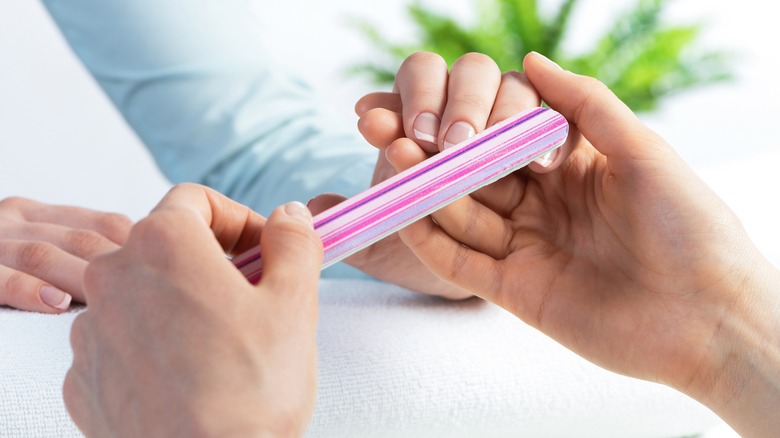Here's What You Should Do If You Bruise A Fingernail
There is something irresistible about retelling stories of minor personal injuries. Often, the storyteller deserves some credit for infusing the story with drama and emotion because the tales tend to follow a similar progression: "Wait until you hear what happened. I was [doing something mundane] when I [jammed/slammed/dropped something] on my finger. Now, look at my fingernail. It's black and blue and hurts."
Although it may look like your fingernail has been bruised, the tissue underneath the fingernail is actually the entity that has sustained the injury. Bruising under a fingernail, which is blood that can't escape following a trauma, is called a subungual hematoma (via the Cleveland Clinic). It can take several months for the fingernail to return to its original fleshy color, during which time the injury can remain painful. Plus, the nail may fall off. With several moving parts here, it's crucial to know how to respond so that nothing impedes your recovery. It begins with pain management, and this means reaching for some ice packs and maybe even some bags of frozen peas.
Treat pain first
You should feel immediate relief once you apply ice to your finger, ideally for 20 minutes at a time every two hours on the day you sustained the injury and then four times a day afterward — or as you need to, per MedlinePlus. Ice will help the pain and swelling, but it won't do anything to stop the throbbing. For this, keep your finger elevated above your heart. Some over-the-counter remedies may help, too, though you should talk to your physician for the okay if you have high blood pressure, heart disease, or stomach ulcers. Ibuprofen can relieve the pain and swelling; acetaminophen can also address the pain but not the swelling.
As tempting as it may be, do not take matters into your own hands by attempting to apply a splint to your finger (via Mount Sinai Health System). First aid of this nature should be left to the experts because you could unwittingly cause more damage to your finger. And if you know enough not to apply a splint, steer clear too of trying to drain blood from underneath your finger. Yes, people have tried it, and some of their retellings include unfortunate consequences.
Medical treatment matters
If your hunches are telling you that it would be wise to call your physician and make an appointment, your hunches serve you well. The Cleveland Clinic cautions against regarding a bruised nail as "no biggie" when, in fact, it could need prompt medical attention. So, call within two days of the injury because your finger could be: broken, on its way to becoming permanently deformed, or harboring nerve damage. Your physician is also likely to check your finger for infection, though the signs may already be apparent to you. These signs include fever, redness on the finger, unusual swelling, skin that feels warm to the touch, and, sometimes, the presence of pus (via Medical News Today).
You may have to jump into first aid mode immediately before you see your physician if your damaged nail is hanging on by a thread and bleeding or looks like it will start bleeding once it falls off. In this case, the Cleveland Clinic recommends wrapping a few paper towels around your finger and applying some pressure until it stops bleeding. Once it does, cover the nail with a topical antibiotic ointment — like Neosporin — and then a bandage. It will take at least a few months, but your nail will grow back. So too, no doubt, will some new stories emerge.


